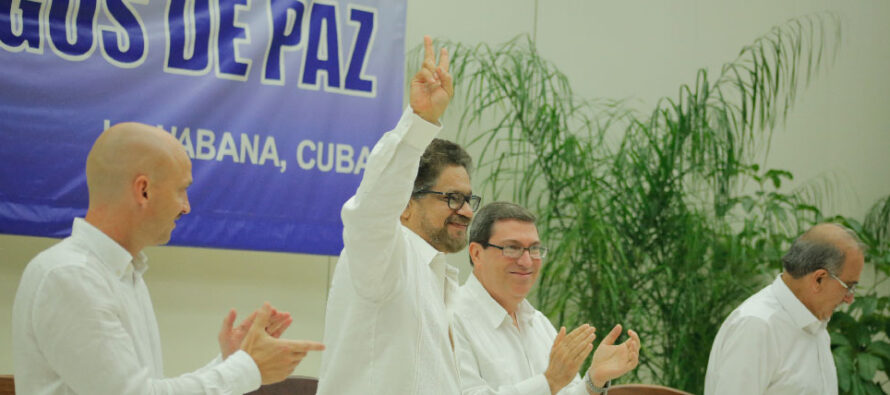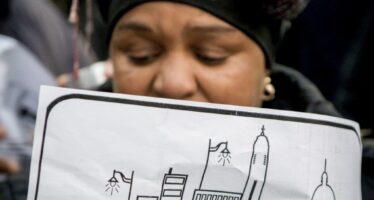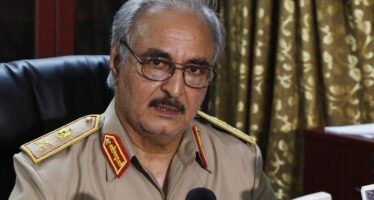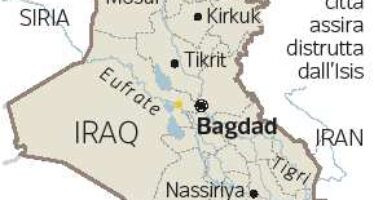A Peace Stable and Lasting in Colombia

![]()
Joint Communique # 93
The delegations of the National Government and the FARC-EP announced to have reached a final, comprehensive and definite agreement on all the points of the agenda of the General Agreement for Termination of Conflict and Building a Peace Stable and Lasting in Colombia.
PREAMBLE
Recalling that the talks in Havana between delegates of the National Government, headed by President Juan Manuel Santos and the delegates of the Revolutionary Armed Forces of Colombia-People’s Army, with the mutual decision to end the national armed conflict, took place as the result of the Exploratory Meeting in the capital of the Republic of Cuba between February 23 and August 26, 2012; ? ?Bearing in mind that as a result of the aforementioned exploratory talks a General Agreement for Termination of Conflict and Building a Stable and Lasting Peace was agreed and signed on 23 August before national witnesses and delegates of the Republic of Cuba and the Kingdom of Norway which were also witnesses, and since then have been acted as the process guarantor countries; ? ?Bearing in mind that the Bolivarian Republic of Venezuela and the Republic of Chile have primed at all times to act as accompanying countries; ? ?Recalling that following on the agenda adopted in the agreement in question the Negotiating Table was established on 18 October 2012 in the city of Oslo, the capital of the Kingdom of Norway, to then continue in Havana without continuity solution until today that the Final Agreement for Termination of Conflict and Building a Stable and Lasting Peace is signed; ? ?Underlining that the Final Agreement signed today corresponds to the free expression of the will of the National Government and the FARC-EP, having both acted in good faith and with the full intention of fulfilling the agreement; ? ?Bearing in mind that Article 22 of the Political Constitution of the Republic of Colombia imposes peace as a right and a mandatory duty; that Article 95 states that the quality of Colombian exalts all members of the national community therefore it is the duty of all to honor and dignify it; that the exercise of the rights and liberties recognized in the Constitution imply responsibilities, including foster the achievement and maintenance of peace; ? ?Stressing that peace has come to be universally qualified as a human right and a necessary condition for the exercise of all other rights and duties of individuals and citizens; ? ?Underlying that the Final Agreement contains all of the agreements reached on the Agenda of the General Agreement signed in Havana in August 2012; and that to achieve it, both the National Government and the FARC-EP have always and every time adhered to the spirit and respect for the Constitution, the principles of International Law, the International Law of Human Rights, International Humanitarian Law (Conventions and protocols), the mandate by the Rome Statute (International Criminal law), of the rulings handed down by the Inter-American Court of Human Rights concerning conflicts and completion, and other statements of universally recognized competence and pronouncements of authority concerning issues underwritten; ? ?Recalling that Article 94 states that “the enunciation of rights and guarantees contained in the Constitution and in international agreements in force, should not be intended as a denial of others which, being inherent to the human person, are not expressly mentioned in them”, that human rights treaties approved by Congress, and that can not be suspended even during states of emergency, prevail in domestic order; ? ?Taking into consideration that the totality of the agreements that form the Final Agreement contribute to the satisfaction of fundamental rights such as political, social, economic and cultural rights, and the rights of the victims of the conflict to truth, justice and reparation; the right of children and adolescents, the fundamental right, individual or collective, to legal safety and personal security, and the fundamental right of every individual in particular and of society without discrimination, to non-repeatition of the tragedy of the internal armed conflict with this Agreement aims to overcome; ? ?Underlining that the Final Agreement pays special attention to the fundamental rights of women, vulnerable social groups such as indigenous peoples, children and adolescents, black communities and other ethnically distinct groups; the fundamental rights of the peasants, the essential rights of people in disability status and displaced because of the conflict; the fundamental rights of older persons and the LGBTI population; ? ?Considering that in the opinion of the national government the transformations involved in implementing of this Agreement should help to reverse the effects of conflict and to change the conditions that have facilitated the persistence of violence in the territory; and that in the opinion of the FARC-EP these changes should help solve the historical causes of conflict, such as the unresolved issue of land ownership and particularly its concentration, the exclusion of the peasantry and the backwardness of rural communities, especially it affects women and children. ? ?Valuing and exalting that the central axis of peace is to promote the presence and effective State action throughout the national territory, especially in many regions crippled today by abandonment, by the lack of an effective civil service, and by the effects of the same internal armed conflict; which it is essential goal of national reconciliation to build a new paradigm of development and territorial welfare for the benefit of broad sectors of the population so far victim of exclusion and despair; ? ?Recognizing the rights of society to comprehensive human security with participation of the civil authorities; ? ?Exalting and enshrining the prospective justice as it recognized essential fundamental rights for new and future generations as the right to a preserved land, the right to the preservation of the human species, the right to know one own’s origins and identity, the right to exemption from liability for the actions committed by previous generations, the right to the preservation of freedom of choice, and other rights, without prejudice to the rights of victims to truth, justice and reparation;
Recalling that on 23 June this year, the delegations of the National Government and the FARC-EP signed in Havana agreements on Bilateral and Permanent Ceasefire and End of Hostilities and of Putting of Arms beyond use and security guarantees, in the presence of the President of the Councils of State and Ministers of the Republic of Cuba, the Secretary General of the United Nations, the President of the General Assembly of the UN, the President of the Security Council of the same organization, the Minister of Foreign Affairs of the Kingdom of Norway, the Heads of State of the accompanying countries of Heads of Government of countries in the region, the Special Envoy of the United States of America and the Special Representative of the European Union; ? ?Accepting that the rules of customary international law continue to govern questions related to fundamental rights not mentioned in the Final Agreement, including the mandatory instructions mandating that “in cases not covered by the law in force, the human person remains under the protection of the principles of humanity and the demands of the public conscience”; ? ?Recognizing the constitutional mandate stating that it corresponds to the President of the Republic as Head of State, Head of Government and supreme administrative authority to agree and ratify peace agreements; ? ?The Government of the Republic of Colombia and the Revolutionary Armed Forces of Colombia-People’s Army, have agreed to: ? ?Sign this Final Agreement for Termination of Conflict and Building of a Stable and Lasting Peace, understanding that its execution will end in a definitive way to an armed conflict lasting for over fifty years. ? ?This Final Agreement ending the conflict and building a stable and lasting peace is signed by the National Government and the Revolutionary Armed Forces of Colombia-People’s Army (FARC-EP), as a Special Agreement under the terms of Article 3 common to the Geneva Conventions of 1949. ? ?The National Government and the Revolutionary Armed Forces of Colombia-People’s Army (FARC-EP), signed seven originals including annexes, one for each of the parts, one for each of the guarantor countries and one for each of the facilitating countries. The original seventh copy will be deposited immediately upon signature, to the Swiss Federal Council in Bern or to the body that replaces it in the future as depository of the Geneva Conventions.
INTRODUCTION
After a standoff of more than half a century, the National Government and the FARC-EP have agreed to definitively end the internal armed conflict. ? ?The termination of the armed conflict will mean, first, putting an end to the enormous suffering that the conflict has caused. Millions of Colombians have been forcibly displaced, hundreds of thousands have died, tens of thousands are missing, not to mention the large number of populations that has been affected in one way or another throughout the territory, including women, children and adolescents, rural communities, indigenous, Afro-Colombian, black, palenqueras, native islanders and Roma, political parties, social movements and trade unions, business associations, among others. We do not want another victim in Colombia. ? ?Second, the end of the conflict will open a new chapter in our history. It means to begin a transition phase that will contribute to greater integration of our territories, greater social inclusion – especially of those who have lived on the margins of development and have suffered from the conflict – and that will strengthen our democracy so it can be deployed throughout the country and ensure that social conflicts are processed through institutional channels, with full guarantees for those involved in policy. ? ?This is about building a stable and lasting peace, with the participation of all Colombians. To that purpose, to end once and forever the historical cycles of violence and lay the foundation for peace, we agreed the points on the Agenda of the General Agreement of August 2012, which this Agreement develops. ? ?The Agreement consists of a series of agreements, which nevertheless constitute an indissoluble body, because they are permeated by the same rights approach, so that the measures agreed here contribute to the realization of the constitutional rights of Colombians; by the same differential and gender approach to ensure that implementation is made taking into account the diversity of gender, ethnic and cultural, and that measures will be taken for the populations and the poorest and most vulnerable groups, especially children and girls, women, people on disability status and victims; and especially by the same territorial approach. ? ?The territorial approach of the Agreement is to recognize and take into account the needs, characteristics and economic, cultural and social characteristics of the territories and communities, ensuring social and environmental sustainability; and seek to implement the various measures in a comprehensive and coordinated manner with the active participation of citizens. The implementation will be done from the regions and territories and with the participation of local authorities and the various sectors of society. ?Citizen participation is the foundation of all agreements constituting the Final Agreement. General participation of the society in building peace and participation particularly in the planning, implementation and monitoring plans and programs in the territories, which is also a guarantee of transparency. ? ?In addition, participation and dialogue among different sectors of society contribute to building confidence and promoting a culture of tolerance, respect and coexistence in general, which is a goal of all agreements. Decades of conflict have opened gaps of distrust within the society, especially in the areas most affected by the conflict. To break these barriers requires open spaces for the most diverse citizen participation and facilities to promote the recognition of victims, recognition and establishment of responsibilities, and in general, the recognition by the whole society of what happened and the need to seize the opportunity for peace. ? ?Therefore, the Government of Colombia and the FARC-EP, with the aim to further consolidate the bases on which peace and national reconciliation will be built, once made the plebiscite, shall convene all parties, political movements and social and all the forces in the country to agree a great NATIONAL POLITICAL AGREEMENT aimed at defining the reforms and institutional adjustments needed to meet the challenges that peace demands, launching a new policy framework and social coexistence. ? ?* ?The Final Agreement contains the following points, with corresponding agreements, which aim to contribute towards the necessary transformations to lay the foundations for a stable and lasting peace.
Point 1 contains the “Comprehensive Rural Reform,” which will contribute to the structural transformation of the field, closing the gaps between rural and urban areas and creating welfare conditions and good living for the rural population. The “Comprehensive Rural Reform” should integrate the regions, helping to eradicate poverty, promote equality and ensure full enjoyment of citizenship rights.
Point 2 contains the agreement “Political participation: Democratic Opening to build peace”. The construction and consolidation of peace, within the frame of the end of the conflict, requires a democratic enlargement that would allow the emergence of new forces in the political arena to enrich the debate and deliberation about major national issues and, in that way, strengthen pluralism and therefore the representation of different views and interests of society, with due guarantees for participation and political inclusion. ? ?In particular, the implementation of the Final Agreement will contribute to the broadening and deepening of democracy as it will involve putting weapons beyond use and the proscription of violence as a method of political action for all Colombians, allowing to move to a scenario where democracy rules, with full guarantees for those involved in politics, and thus open new spaces for participation.
Point 3 contains the agreements on “Bilateral and Permanent Ceasefire and Termination of Hostilities and Putting of Arms beyond use”, which aim to permanently end offensive actions between the security forces and the FARC-EP, and in general hostilities and any action under the rules governing the Ceasefire, including the effect on the population, and thus create conditions for the start of the implementation of the Final Agreement and the putting of weapons beyond use and prepare institutions and the country to the reinstatement of the FARC-EP to civilian life.
Point 3 also contains the agreement on “Reincorporation of the FARC-EP into civilian life – in social, economic, political terms – according to their interests”. Laying the basis for building a stable and lasting peace requires the effective reinstatement of the FARC-EP to social, economic and political life of the country. Reincorporation confirms the commitment of the FARC-EP to close the chapter of internal conflict, to become valid actor in democracy and contribute decisively to the consolidation of peaceful coexistence, to non-repetition, and to transform the conditions that facilitated the persistence of violence in the territory.
Point 3 also includes the agreement on “Ensuring security and the fight against criminal organizations responsible for killings and massacres or threaten against defenders of human rights, social movements and political movements, including the criminal organizations that have been designated as successor of paramilitarism and their support networks, and prosecution of criminal behavior that threaten the implementation of agreements and peace building”. To meet this end, the agreement includes measures such as the National Political Pact; the National Commission on Security Assurances; the Special Investigation Unit; Elite Corps in the National Police; Integral Security System for Exercise Policy; Integral Security and Protection Program for Communities and Organizations in the Territories; and Measures for Prevention and Fight against Corruption.
Point 4 contains the agreement “Solution to the Problem of Illicit Drugs”. To build peace it is necessary to find a definitive solution to the problem of illicit drugs, including illicit crops and the production and marketing of illicit drugs. For this it is promoted a new vision that gives a different treatment and differential to the phenomenon of consumption, the problem of illicit crops, and organized crime associated with drug trafficking, ensuring a comprehensive approach to human rights and public health, differentiated and of genre.
Point 5 contains the “Victims” agreement. From the Exploratory Meeting of 2012, we agreed that compensation for victims should be at the core of any agreement. The agreement creates the Integral System of Truth, Justice, Reparation and Non-Repetition, that contributes to the fight against impunity combining judicial mechanisms for the investigation and punishment of serious violations of human rights and grave breaches of International Humanitarian Law, with complementary judicial mechanisms that contribute to the clarification of truth on facts, the search for missing loved ones and reparation of the damage caused to individuals, groups and entire territories. ? ?The Integral System is composed of the Commission for the Clarification of Truth, Coexistence and non-repetition; the Special Unit for the search of persons missing in the context and because of the armed conflict; the Special Court for Peace; Measures integral reparation for building peace; and guarantees of non repetition.
Point 6 contains the “Implementation and Verification Mechanisms” agreement in which a “Commission of implementation, monitoring and verification of the Final Peace Agreement and resolution of differences” is created, composed of representatives of the National Government and the FARC is created EP in order, inter alia, to track the components of the Agreement and verify its implementation, as well as serve to resolve differences, and promoting and monitoring the legislative implementation. ? ?Additionally it creates a mechanism of support so that the international community could contribute in different ways to ensure the implementation of the Final Agreement and on verification it starts a model with an international component to be integrated by countries that have had the role of guarantors and accompanying countries during the process and two international spokespeople, all supported on the technical capacity of the Kroc Institute for international Peace Studies Project at the University of Notre Dame, United States.
* ? ?The delegations of the National Government and the FARC-EP reiterate our profound gratitude to all victims, social and human rights organizations, communities including ethnic groups, women’s organizations, the peasants, youth , academia, business, church and faith communities, and all citizens who actively participated and who through their proposals contributed to the Final Agreement. With their participation we will achieve the building of a stable and lasting peace.
Related Articles
«Radicalizzati per trovare un senso»
![]()
Intervista. Marco Martiniello, docente di sociologia a Liegi, esperto di multiculturalità. «Non tutti gli esclusi seguono la via del radicalismo, o passano alla violenza. Si può vivere pacificamente nel proprio estremismo»
In Libia guerra per porti e petrolio, rapito il vicepremier al Majbari
![]()
Caos Libia. Haftar consegna i proventi dei traffici alla Noc di Baida, ma le potenze occidentali lo diffidano
Le ruspe su Nimrud L’Unesco: «Crimine contro l’umanità»
![]()
I fanatici jihadisti hanno iniziato la devastazione metodica dell’antica città assira di Nimrud, uno dei siti mesopotamici più celebri al mondo





